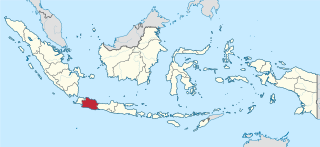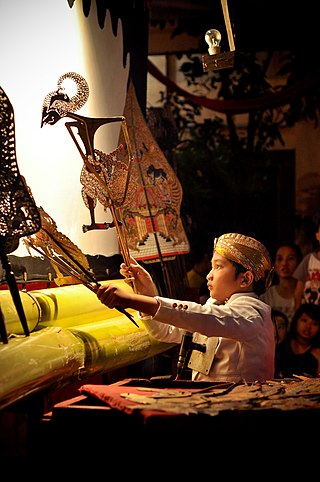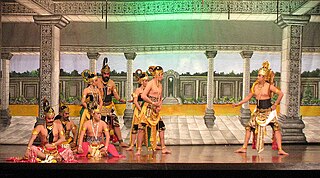
Gamelan is the traditional ensemble music of the Javanese, Sundanese, and Balinese peoples of Indonesia, made up predominantly of percussive instruments. The most common instruments used are metallophones and a set of hand-drums called kendang, which keep the beat. The kemanak, a banana-shaped idiophone, and the gangsa, another metallophone, are also commonly used gamelan instruments on Bali. Other notable instruments include xylophones, bamboo flutes, a bowed string instrument called a rebab, and a zither-like instrument called a siter, used in Javanese gamelan. Additionally, vocalists may be featured, being referred to as sindhen for females or gerong for males.

Gamelan degung is a form of Sundanese musical ensemble that uses a subset of modified gamelan instruments with a particular mode of degung scale. The instruments are manufactured under local conditions in towns in West Java such as Bogor and Bandung. Degung music is often played at public gatherings in West Java, such as at local elections, as well as many other events. There is international interest in degung as well among communities in other countries interested in Indonesian and gamelan music.

West Java is an Indonesian province on the western part of the island of Java, with its provincial capital in Bandung. West Java is bordered by the province of Banten and the country's capital region of Jakarta to the west, the Java Sea to the north, the province of Central Java to the east and the Indian Ocean to the south. With Banten, this province is the native homeland of the Sundanese people, the second-largest ethnic group in Indonesia.

Central Java is a province of Indonesia, located in the middle of the island of Java. Its administrative capital is Semarang. It is bordered by West Java in the west, the Indian Ocean and the Special Region of Yogyakarta in the south, East Java in the east, and the Java Sea in the north. It has a total area of 33,750.37 km2, with a population of 36,516,035 at the 2020 Census making it the third-most populous province in both Java and Indonesia after West Java and East Java. The official population estimate in mid-2023 was 37,608,336 The province also includes a number of offshore islands, including the island of Nusakambangan in the south, and the Karimun Jawa Islands in the Java Sea.

Wayang, also known as wajang, is a traditional form of puppet theatre play originating from the Indonesian island of Java. Wayang refers to the entire dramatic show. Sometimes the leather puppet itself is referred to as wayang. Performances of wayang puppet theatre are accompanied by a gamelan orchestra in Java, and by gender wayang in Bali. The dramatic stories depict mythologies, such as episodes from the Hindu epics the Ramayana and the Mahabharata, as well as local adaptations of cultural legends. Traditionally, a wayang is played out in a ritualized midnight-to-dawn show by a dalang, an artist and spiritual leader; people watch the show from both sides of the screen.

The Music of Java embraces a wide variety of styles, both traditional and contemporary, reflecting the diversity of the island and its lengthy history. Apart from traditional forms that maintain connections to musical styles many centuries old, there are also many unique styles and conventions which combine elements from many other regional influences, including those of neighbouring Asian cultures and European colonial forms.

Shadow play, also known as shadow puppetry, is an ancient form of storytelling and entertainment which uses flat articulated cut-out figures which are held between a source of light and a translucent screen or scrim. The cut-out shapes of the puppets sometimes include translucent color or other types of detailing. Various effects can be achieved by moving both the puppets and the light source. A talented puppeteer can make the figures appear to walk, dance, fight, nod and laugh.

Dalang or dhalang is a native Javan term commonly used in Javan–Bali cultures, referring to the individuals who responsible as the plotter or puppeteer of various Wayang performance. Originating from the Javanese cultural tradition, the Dalang practice first emerged and developed on the Indonesian island of Java, particularly in the courts of central–southern regions which considered as the origin place of these traditional cultural practice. Due to the massive spread of Central Javanese influence, the practice of Dalang puppeteering was also introduced to its vicinity eastern region, which now comprises the states of East Java and Bali.

Yogyakarta is the capital city of the Special Region of Yogyakarta in Indonesia, in the south-central part of the island of Java. As the only Indonesian royal city still ruled by a monarchy, Yogyakarta is regarded as an important centre for classical Javanese fine arts and culture such as ballet, batik textiles, drama, literature, music, poetry, silversmithing, visual arts, and wayang puppetry. Renowned as a centre of Indonesian education, Yogyakarta is home to a large student population and dozens of schools and universities, including Gadjah Mada University, the country's largest institute of higher education and one of its most prestigious.

Wayang wong, also known as wayang orang, is a type of classical Javanese and Balinese dance theatrical performance with themes taken from episodes of the Ramayāna or Mahabharāta. Performances are stylised, reflecting Javanese court culture:
Wayang wong dance drama in the central Javanese Kraton of Yogyakarta represents the epitome of Javanese aesthetic unity. It is total theatre involving dance, drama, music, visual arts, language, and literature. A highly cultured sense of formality permeates every aspect of its presentation.

Gamelan, although Indonesia is its origin place, is found outside of that country. There are forms of gamelan that have developed outside Indonesia, such as American gamelan and Malay Gamelan in Malaysia.

The Sonobudoyo Museum is a Javanese history and culture museum and library in Yogyakarta, Indonesia. The museum contains the most complete collection of Javanese artifacts, after the National Museum in Jakarta. In addition to ceramics of the Neolithic era and bronze sculptures from the 8th century, the museum also includes collections of wayang, various ancient weapons, and Javanese masks.

The Wayang Museum is a museum dedicated to Javan wayang puppetry. The museum is located in Kota Tua, Jakarta, Indonesia. It is one of several museums and galleries facing Fatahillah Square, which include the Jakarta History Museum, Fine Art and Ceramic Museum, and Kota Post Office art gallery.

Indonesia and Mexico established diplomatic relations in 1953. Both nations view their counterpart as strategic partners in each other's regions; Indonesia in Southeast Asia and Mexico in Latin America. Both nations are mutual members of the Asia-Pacific Economic Cooperation, Forum of East Asia-Latin America Cooperation, Group of 15, G-20 major economies, MIKTA, United Nations, and the World Trade Organization.

Wayang kulit is a traditional form of shadow puppetry originally found in the cultures of Java and Bali in Indonesia. In a wayang kulit performance, the puppet figures are rear-projected on a taut linen screen with a coconut oil light. The dalang manipulates carved leather figures between the lamp and the screen to bring the shadows to life. The narratives of wayang kulit often have to do with the major theme of good vs. evil.

It is quite difficult to define Indonesian art, since the country is immensely diverse. The sprawling archipelago nation consists of 17.000 islands. Around 922 of those permanently inhabited, by over 1,300 ethnic groups, which speak more than 700 living languages.

Fitra Ismu Kusumo is a promoter of Indonesian art and Culture in Mexico, since 2002 and founder of Indra Swara, introducing Indonesia through Gamelan, Indonesian traditional dances and also through its puppeteering art. As a researcher his area of specialty is Muslims and Islam in Mexico and Latin America.

Indonesian theatre is a type of art in the form of drama performances that are staged on a stage, with a distinct Indonesian nuance or background. In general, theatre is an art that emphasizes the performing arts that are displayed in front of a large crowd. In other words, theater is a form of visualisation of a drama that is staged on the stage and watched by the audience. Indonesian theatre includes the performing arts of traditional theater and modern theatre located in the territory of Indonesia. Some examples of Indonesian theater are Arja, Wayang, Wayang wong, Lenong, Ludruk, Janger, Randai and others. Theatre in Indonesia can also be referred to as regional or ethnic theatre, because it originates and develops from 1,300 ethnic cultures in Indonesia.

Wayang beber is an Indonesian wayang performance art whose presentation is manifested in a stretch sheets of paper or cloth with pictures in the stylized wayang accompanied by a narration by a dalang. Wayang beber performances emerged and developed in Java in pre-Islamic times, but continued into the Islamic kingdoms. The stories shown are taken from the Mahabharata and the Ramayana. After Islam became the main religion in Java, more Panji stories were shown. Wayang beber bears a strong resemblance to narrative in the form of pictorial ballads common at annual fairs in medieval and early modern Europe. They too suffered the same fate—nearly extinct, although there are still groups of artists who support wayang beber in places like Surakarta (Solo) in Central Java.


























